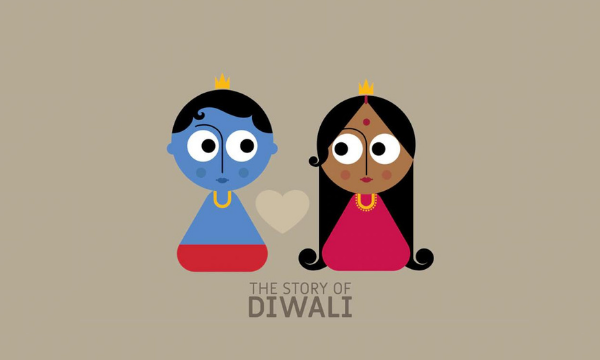All about Diwali — The Festival of Lights!

Summer is a troublesome season in India, that’s why rain is welcomed with pomp in India. Rain is considered the queen of all the seasons of India. With the end of the rains, the arrival of autumn, which is the most favorable season for the people coming to India. That is why from October to February, India attracts tourists the most. Diwali is the festival to welcome this autumn. The festival of lamps and lights, the festival of happiness and gaiety, the festival of fairs, and that too not for one or two days, but for five days. The festival of Diwali starts from Dhanteras and continues for five consecutive days till Bhaiya Dooj.
This festival is celebrated equally throughout the country and is celebrated by all Hindus, Sikhs, Jains, and Buddhists. This is the reason that in most countries of the world, Hindus officially get a Diwali holiday on this day. Nepal, Sri Lanka, Bhutan, Burma, Mauritius, Guyana, Well, in Thailand, this day is a state holiday and all business is closed except for essential services. But in America, Australia, and Britain, Hindus get a holiday on this day. Since the year 2003, every year on the day of Deepawali, the tradition of decorating the White House of America with lights has been going on.
However, like other festivals in India, the tradition of celebrating it is different. For example, some call it the festival of the arrival of Lakshmi, while for some, Lord Sri Rama returned to Ayodhya after conquering Lanka on this day, then some belief says that the Pandavas had come this day after spending 12 years of exile and one year of exile. On the contrary, in South India, it is celebrated as Narakasura Vijay. According to the belief, Dwarka king Shri Krishna along with his wife Satyabhama killed Narakasura on this day. It is also believed in Tamil Nadu that on this day Vishnu had donated everything from Asura King Bali during Vamanavatar. That is why it is also called Bali Padwa there. But Gujarat, Their Panchang begins with Diwali in the Marwar region of Maharashtra and Rajasthan. It is recognized as Gudi Padwa.
In Bengal and Eastern India, it is called Kali Puja, which comes twenty days after the arrival of Goddess Durga in her maternal home. In many other places, it is considered a festival of tantric, and it is believed that tantra lore awakens on this day. According to Jains, their 24th Tirthankar Mahavir Swami attained Nirvana on the day of Deepawali. Swami Dayanand Saraswati, the founder of Arya Samaji, died on the day of Deepawali.
But as much as this festival of lights has religious significance, it is also a festival of gaiety. The amount of shopping that happens on this day in the whole country is probably not in any festival. Even the poorest of the poor want to buy everything from utensils to clothes, jewelry, house, and car during Diwali. That is why traders also call it the festival season. Which starts from Pratipada of Ashwin Shukla Paksha i.e. Navratri and runs from Kartik Amavasya Deepawali to Kartik Poornima i.e. the birthday of Guru Nanak Dev. You will find that most discount or deal shops run this season. This is also the season of all new work and marriage. The number of vehicles sold in this festive season is not sold throughout the year. Although the season of Chaitra Navratri lasts from the last week of March to the first week of April, due to the heat, the market is almost deserted during that season. That is why the importance of Diwali is more.
Actually, India has been an agricultural country, so festivals have been celebrated here since the beginning. Being a tropical country, mainly two crops have been special here, Rabi and Kharif. Rabi harvesting starts in March and Kharif from mid-September. Since paddy is the main crop here and paddy is the basis of Kharif, so money comes to the farmer only after the paddy crop arrives. The paddy is harvested by now and the farmer has money to spend. Mahajan gives money to the farmer only when he brings the paddy to home. This is the festival of paddy, it is also called the festival of wealth and grain. In Diwali, Lai and Khel are specially offered to Goddess Lakshmi. It is celebrated with great pomp all over India. On the one hand, the crop of paddy comes home, on the other hand, that of pulses, it is known that this is also the time of harvesting of pulse crops like urad, lentil, and moong. Whereas in Rabi crops wheat, gram, Mustard and tur. This is the reason that in western Uttar Pradesh, Haryana, and Punjab, the festival of Baisakhi is also celebrated with equal gaiety. Only when the money comes to the farmer, he will be able to be happy. Festivals have been celebrated in this way.
The economy of the whole of India has also been running on the basis of the festive season. Even though technology has become important in the economy today and factories tomorrow, but still the backbone is agriculture. Even so, exports in India are mostly of agricultural produce, so the consumer is also able to buy only on the basis of fluctuating agricultural produce. In Haryana and Punjab, the festival of Baisakhi is also celebrated with equal gaiety. Only when the money comes to the farmer, he will be able to be happy. Festivals have been celebrated in this way. The economy of the whole of India has also been running on the basis of the festive season.
Today even though technology has become important in the economy and tomorrow factories are still the backbone of agriculture. Even so, exports in India are mostly of agricultural produce, so the consumer is also able to buy only on the basis of fluctuating agricultural produce. In Haryana and Punjab, the festival of Baisakhi is also celebrated with equal gaiety. Only when the money comes to the farmer, he will be able to be happy. Festivals have been celebrated in this way. The economy of the whole of India has also been running on the basis of the festive season. Even though technology has become important in the economy today and factories tomorrow, but still the backbone is agriculture. Even so, exports in India are mostly of agricultural produce, so the consumer is also able to buy only on the basis of fluctuating agricultural produce.
You see that every year before the monsoon, car dealers cry that car sales in India have decreased, but the figures that come after Diwali show that car sales grew by two percent compared to last year. Obviously, all this game is about agricultural produce. If sugarcane is the basis of Chaitra April Navratri, then paddy is the basis of Ashwin Navratri. Sugarcane harvesting starts some time before Deepawali and Holi continues till the end. That is, the real fun of the sugarcane crops is between Diwali and Holi. This is the basis of our money coming here. Even the urban working classes get their wage standard on the basis of agricultural produce. Whether it is a bonus to central employees or their salary recommendations. This salary increase and bonus become the means of their purchase. Throughout the year people wait to see when bonuses are available and make additional purchases. Diwali becomes an excuse for this shopping.
This Diwali festival starts with Dhanteras. It is believed that some shopping must be done on this day. The day of Dhanteras is considered auspicious for the purchase of utensils, vehicles, and gold. People shop till late at night on the day of Dhanteras. Similarly, the next day celebrates Choti Diwali i.e. Narkachaudas. It is a religious belief that on this day Shri Krishna killed Narakasura. On this day people clean their house. Dirt is removed from every corner. If possible, cleaning and dyeing the house should also be done on this day. On this day, one or two diyas are kept in the bathroom and outside the house during the night and it is said that all the bad omen inside the house should be removed. The third day is of Diwali. On this day there is a lot of hustle and bustle since morning. From the worship of the account, this day is the day of not spending money. Generally shopping on the day of Diwali is avoided.
In the evening, Ganesha Lakshmi is worshiped in the auspicious time and she is given fruits, flowers, and flowers. Sweets and cakes are offered. Toys made of sugar are also offered to the deity of Ganesha Lakshmi and after the worship, there is a rule to keep lamps and lights in the whole house. It is believed that on this day Lakshmi ji can come to the house at any time of the night, so there should be enough light in the house to welcome her. Since there is also a custom of bursting firecrackers, people release firecrackers after the Bagh Diwali Puja. And often so many crackers are fired that in just one day the pollution in the air rises to dangerous levels. Due to this, people who are asthma patients suffer a lot. Along with this another disease or addiction exposes a dark side of this festival that is gambling. Gambling on Diwali is considered a ritual by people, but how much money they lose by gambling that this festival of laughter and gaiety turns into mourning. And after the worship, there is a rule to keep lamps and lights in the whole house. It is believed that on this day Lakshmi ji can come to the house at any time of the night, so there should be enough light in the house to welcome her. Since there is also a custom of bursting firecrackers, people release firecrackers after the Bagh Diwali Puja. And often so many crackers are fired that in just one day the pollution in the air rises to dangerous levels.
Due to this, people who are asthma patients suffer a lot. Along with this another disease or addiction exposes a dark side of this festival that is gambling. Gambling on Diwali is considered a ritual by people, but how much money they lose by gambling that this festival of laughter and gaiety turns into mourning. And after the worship, there is a rule to keep lamps and lights in the whole house. It is believed that on this day Lakshmi ji can come to the house at any time of the night, so there should be enough light in the house to welcome her. Since there is also a custom of bursting firecrackers, people release firecrackers after the Bagh Diwali Puja. And often so many crackers are fired that in just one day the pollution in the air rises to dangerous levels. Due to this, people who are asthma patients suffer a lot. Along with this another disease or addiction exposes a dark side of this festival that is gambling. Gambling on Diwali is considered a ritual by people, but how much money they lose by gambling that this festival of laughter and gaiety turns into mourning. There should be enough light in the house. Since there is also a custom of bursting firecrackers, people release firecrackers after the Bagh Diwali Puja. And often so many crackers are fired that in just one day the pollution in the air rises to dangerous levels. Due to this, people who are asthma patients suffer a lot. Along with this another disease or addiction exposes a dark side of this festival that is gambling. Gambling on Diwali is considered a ritual by people, but how much money they lose by gambling that this festival of laughter and gaiety turns into mourning. There should be enough light in the house.
Since there is also a custom of bursting firecrackers, people release firecrackers after the Bagh Diwali Puja. And often so many crackers are fired that in just one day the pollution in the air rises to dangerous levels. Due to this, people who are asthma patients suffer a lot. Along with this another disease or addiction exposes a dark side of this festival that is gambling. Gambling on Diwali is considered a ritual by people, but how much money they lose by gambling that this festival of laughter and gaiety turns into mourning. It reveals that gambling. Gambling on Diwali is considered a ritual by people, but how much money they lose by gambling that this festival of laughter and gaiety turns into mourning. It reveals that it is gambling. Gambling on Diwali is considered a ritual by people, but how much money they lose by gambling that this festival of laughter and gaiety turns into mourning.
The festival of the next day of Deepawali is Govardhan or Annakoot Puja. It is believed that on this day Vishnu had finished the worship of Indra and started his worship, hence it is a festival celebrated on the next day of Deepawali. After this, the festival of Bhaiya Dooj is celebrated on the third day. It is believed that on this day in Mathura, Yama got vaccinated from Yami. Yami means Yamuna river which is the younger sister of Yama. That is why Yama Dwitiya i.e. Bhai Dooj festival is celebrated. In this, sisters vaccinate their brothers. And in return, the brother takes an oath to protect the sister. This festival, which runs from Dhanteras to Bhai Dooj, ends with this. But the specialty of this festival is the shopping done during this time, that is why this festival is a festival of happiness and to increase business for the traders. All the hope of the entire merchant society rests on this festival. Be it Delhi or Mumbai or Kolkata, Traders from all over Chennai or Bangalore wait for the festive season of Diwali. The sale of real estate to vehicles and jewelry etc. is highest in this one season.
All the rules, regulations, and festivals of any society are in one way or the other the backbone of its economy. Just as the Muslim society does a lot of shopping on Eid and the Christian society does a lot of shopping on the occasion of Christmas, in the same way, Hindus, Jains, Sikh, and Buddhist societies wait for this festival throughout the year. This festival is the pivot of the Indian agricultural economy which has been going on for years. The Planning Commission had told in one of its surveys that the basis of total plan expenditure of India is money coming on Diwali. The real market for the Indian consumer is actually Diwali. All other festivals have religious significance but Deepawali has a commercial significance. Isn’t it strange that last year alone in Diwali alone, sweets worth ten thousand crores were sold and cars worth more than a thousand crores? The sale of gold and silver is also highest in this season and also of clothes. Due to giving gifts and gifts on this occasion, the sale of all the gift items also increases. That is, the market of Diwali alone is about one lakh crores in our country. Why not such a festival bring happiness and gifts to everyone. This zeal and enthusiasm of Diwali should continue. Why not such a festival bring happiness and gifts to everyone. This zeal and enthusiasm of Diwali should continue. Why not such a festival bring happiness and gifts to everyone. This zeal and enthusiasm of Diwali should continue.
Also Read: 5 Top Most Feared Yogas in Astrology









